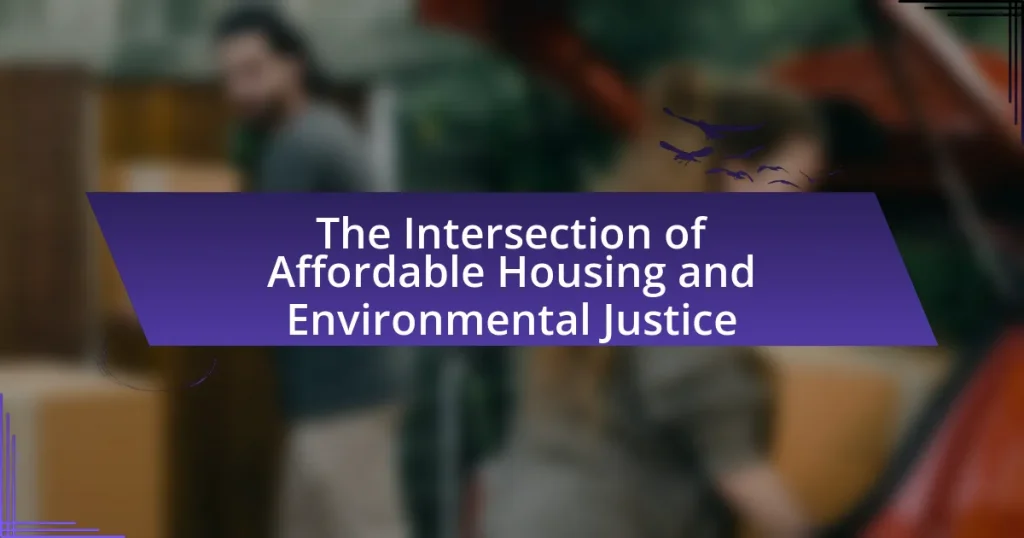Local governments are essential in promoting housing affordability and equity through various policies and initiatives. They regulate land use and zoning, implement inclusionary zoning, and provide financial incentives to support low-income housing development. The article examines how local governments influence housing policies, address equity in housing access, and the social and economic implications of housing affordability. It also discusses the challenges faced by local governments, including financial constraints and community opposition, while highlighting successful strategies and collaborations with non-profit organizations and the private sector to enhance housing access and sustainability.

What is the Role of Local Governments in Promoting Housing Affordability and Equity?
Local governments play a crucial role in promoting housing affordability and equity by implementing policies that regulate land use, zoning, and housing development. They can create affordable housing initiatives, such as inclusionary zoning, which requires developers to include a percentage of affordable units in new projects. Additionally, local governments can provide financial incentives, such as tax credits or grants, to support low-income housing development. According to the National Low Income Housing Coalition, there is a shortage of 7 million affordable rental homes for extremely low-income renters, highlighting the need for effective local government intervention. By prioritizing affordable housing in their planning and budget decisions, local governments can address disparities and ensure equitable access to housing for all residents.
How do local governments influence housing policies?
Local governments influence housing policies through zoning regulations, land use planning, and the implementation of local ordinances. By establishing zoning laws, local governments dictate the types of housing that can be built in specific areas, which directly affects housing density and affordability. For instance, cities may promote affordable housing by allowing higher density developments or mixed-use zoning, which can lead to a greater supply of lower-cost housing options. Additionally, local governments can implement policies such as inclusionary zoning, which requires developers to include a percentage of affordable units in new housing projects. Evidence of this influence can be seen in cities like San Francisco, where local policies have aimed to increase affordable housing stock amid rising costs.
What specific policies do local governments implement to promote housing affordability?
Local governments implement various policies to promote housing affordability, including inclusionary zoning, rent control, and the provision of affordable housing subsidies. Inclusionary zoning requires developers to include a percentage of affordable units in new housing projects, which helps increase the supply of affordable homes. Rent control policies limit the amount landlords can increase rent, protecting tenants from sudden price hikes. Additionally, affordable housing subsidies, such as vouchers or direct funding for low-income housing projects, provide financial assistance to help lower-income families access housing. These policies are supported by studies indicating that such measures can effectively increase housing affordability and reduce displacement in urban areas.
How do local governments address equity in housing access?
Local governments address equity in housing access by implementing policies that promote affordable housing development, zoning reforms, and inclusionary housing programs. These initiatives aim to reduce barriers for low-income and marginalized communities, ensuring they have equal opportunities to secure housing. For instance, cities like San Francisco have adopted inclusionary zoning laws that require developers to allocate a percentage of new housing units for low-income residents, thereby increasing affordable housing stock. Additionally, local governments often provide funding for housing assistance programs and collaborate with non-profit organizations to support vulnerable populations, further enhancing equitable access to housing.
Why is housing affordability important for communities?
Housing affordability is crucial for communities because it directly impacts economic stability and social equity. When housing is affordable, families can allocate more resources to essential needs such as education, healthcare, and savings, which fosters community development. According to the National Low Income Housing Coalition, in 2021, a household would need to earn $24.90 per hour to afford a modest two-bedroom rental home, highlighting the gap between wages and housing costs. This disparity can lead to increased poverty rates and social unrest, undermining community cohesion. Therefore, ensuring housing affordability is essential for promoting a thriving, equitable community.
What are the social implications of unaffordable housing?
Unaffordable housing leads to significant social implications, including increased homelessness, social inequality, and community instability. When housing costs exceed a household’s income, families may face eviction or be forced to live in substandard conditions, contributing to a rise in homelessness. According to the U.S. Department of Housing and Urban Development, in 2020, over 580,000 individuals experienced homelessness on a single night in the United States, highlighting the direct impact of housing affordability on social stability. Furthermore, unaffordable housing exacerbates social inequality, as low-income families are disproportionately affected, limiting their access to essential services such as education and healthcare. This disparity can perpetuate cycles of poverty and hinder social mobility, as evidenced by research from the National Low Income Housing Coalition, which indicates that a lack of affordable housing options correlates with poorer health outcomes and lower educational attainment in affected communities. Overall, the social implications of unaffordable housing are profound, affecting not only individual families but also the broader community fabric.
How does housing affordability impact local economies?
Housing affordability significantly impacts local economies by influencing population growth, consumer spending, and workforce stability. When housing is affordable, more individuals and families can reside in an area, leading to increased demand for local goods and services. For instance, a study by the National Association of Realtors found that for every 1% increase in housing affordability, local retail sales can increase by approximately 0.5%. Additionally, affordable housing contributes to workforce stability, as employees are less likely to relocate for better housing options, thereby reducing turnover costs for businesses. This stability fosters a more robust local economy, as businesses can rely on a consistent workforce to drive productivity and growth.
What challenges do local governments face in promoting housing affordability and equity?
Local governments face significant challenges in promoting housing affordability and equity, primarily due to limited financial resources and regulatory constraints. These entities often operate under tight budgets, which restrict their ability to invest in affordable housing initiatives or subsidize housing costs. Additionally, zoning laws and land-use regulations can hinder the development of affordable housing by imposing restrictions that limit density or increase costs. According to the National Low Income Housing Coalition, there is a shortage of 7 million affordable rental homes for extremely low-income renters, highlighting the systemic barriers local governments encounter. Furthermore, community opposition, often referred to as NIMBYism (Not In My Backyard), can complicate efforts to introduce new housing projects, particularly in affluent neighborhoods. These factors collectively impede local governments’ ability to effectively address housing affordability and equity.
What are the financial constraints affecting local governments?
Local governments face several financial constraints, including limited revenue sources, reliance on property taxes, and budgetary restrictions. These constraints hinder their ability to invest in housing affordability initiatives and equitable development. For instance, many local governments depend heavily on property taxes, which can be volatile and insufficient to meet growing demands for public services and infrastructure. Additionally, state and federal funding cuts further exacerbate financial limitations, reducing the resources available for local housing programs. According to the National League of Cities, nearly 70% of cities report that budget constraints significantly impact their ability to address housing issues effectively.
How do zoning laws impact housing affordability efforts?
Zoning laws significantly impact housing affordability efforts by regulating land use and determining the types of housing that can be built in specific areas. These regulations often restrict the development of high-density housing, which can limit the supply of affordable units. For instance, a study by the National Bureau of Economic Research found that restrictive zoning contributes to increased housing costs, as it reduces the availability of affordable housing options in urban areas. Additionally, zoning laws can create barriers for low-income families by enforcing minimum lot sizes and prohibiting multi-family dwellings, further exacerbating housing shortages and affordability challenges.
How can local governments collaborate with other stakeholders?
Local governments can collaborate with other stakeholders by forming partnerships with non-profit organizations, private developers, and community groups to address housing affordability and equity. These collaborations can involve joint initiatives, such as creating affordable housing projects, sharing resources, and leveraging funding opportunities. For instance, the National Low Income Housing Coalition reports that local governments that engage with stakeholders can increase the effectiveness of their housing policies and programs, leading to improved outcomes in housing accessibility for low-income populations.
What role do non-profit organizations play in housing initiatives?
Non-profit organizations play a crucial role in housing initiatives by providing affordable housing options, advocating for policy changes, and offering support services to low-income families. These organizations often develop and manage housing projects that cater to underserved populations, thereby addressing the gap in affordable housing availability. For instance, according to the National Low Income Housing Coalition, non-profits have been instrumental in creating over 1.5 million affordable housing units across the United States since 1980. Additionally, they engage in community organizing and education to influence local housing policies, ensuring that the needs of marginalized communities are represented in decision-making processes.
How can private sector partnerships enhance housing affordability efforts?
Private sector partnerships can enhance housing affordability efforts by leveraging financial resources, expertise, and innovative solutions to develop affordable housing projects. These collaborations often result in increased investment in housing developments, which can lead to a greater supply of affordable units. For instance, a study by the Urban Land Institute found that public-private partnerships can reduce development costs by up to 20% through shared resources and risk mitigation strategies. Additionally, private sector involvement can introduce new technologies and construction methods that expedite project timelines and lower expenses, further contributing to affordability.

What strategies can local governments adopt to improve housing affordability and equity?
Local governments can adopt inclusionary zoning policies to improve housing affordability and equity. Inclusionary zoning requires developers to include a percentage of affordable units in new housing projects, which directly increases the availability of affordable housing options. For instance, cities like San Francisco have implemented such policies, resulting in thousands of affordable units being created. Additionally, local governments can invest in public housing initiatives and provide subsidies or tax incentives for low-income families, which can further enhance access to affordable housing. Research from the Urban Institute indicates that these strategies can significantly reduce housing cost burdens for low-income residents, thereby promoting equity in housing access.
How can local governments utilize funding and resources effectively?
Local governments can utilize funding and resources effectively by implementing targeted programs that address specific community needs, such as affordable housing initiatives. For instance, the allocation of federal funds through programs like the Community Development Block Grant (CDBG) allows local governments to invest in infrastructure improvements and housing projects that directly benefit low-income residents. According to the U.S. Department of Housing and Urban Development, CDBG has provided over $150 billion since its inception in 1974, demonstrating its impact on local development and housing affordability. By prioritizing projects that enhance equity and accessibility, local governments can ensure that resources are directed toward sustainable community growth and improved living conditions for all residents.
What types of funding sources are available for housing projects?
Various funding sources are available for housing projects, including federal grants, state funding programs, private investments, and nonprofit organization contributions. Federal grants, such as those from the U.S. Department of Housing and Urban Development (HUD), provide significant financial support for affordable housing initiatives. State funding programs often allocate resources specifically for low-income housing development, while private investments can come from real estate developers or financial institutions looking to invest in housing projects. Nonprofit organizations also play a crucial role by offering grants and fundraising efforts aimed at supporting housing affordability and equity initiatives.
How can local governments prioritize resource allocation for maximum impact?
Local governments can prioritize resource allocation for maximum impact by conducting comprehensive needs assessments to identify the most pressing community issues. This approach allows them to allocate funds and resources effectively, ensuring that the most critical areas, such as affordable housing, receive the necessary support. For instance, a study by the Urban Institute found that targeted investments in affordable housing can lead to significant improvements in community well-being and economic stability. By utilizing data-driven decision-making and engaging with community stakeholders, local governments can ensure that their resource allocation aligns with the actual needs of residents, thereby maximizing the impact of their initiatives.
What innovative approaches can local governments explore?
Local governments can explore innovative approaches such as inclusionary zoning, community land trusts, and public-private partnerships to enhance housing affordability and equity. Inclusionary zoning mandates that a percentage of new developments be affordable for low- to moderate-income households, which has been successfully implemented in cities like San Francisco, resulting in thousands of affordable units. Community land trusts allow communities to collectively own land, ensuring long-term affordability and preventing displacement, as demonstrated by the Burlington Community Land Trust in Vermont. Public-private partnerships can leverage private investment for affordable housing projects, exemplified by the partnership between the City of Los Angeles and private developers, which has led to the creation of thousands of affordable units. These approaches not only address immediate housing needs but also promote sustainable community development.
How can technology be leveraged to improve housing access?
Technology can be leveraged to improve housing access by utilizing data analytics, online platforms, and digital tools to streamline the housing search process and enhance affordability. For instance, local governments can implement data-driven decision-making to identify housing needs and allocate resources effectively, as evidenced by cities like San Francisco using data to target affordable housing developments. Additionally, online platforms can connect potential renters and buyers with available housing options, reducing barriers to access. A study by the Urban Institute found that digital tools can increase transparency in housing markets, helping low-income families find suitable housing more easily.
What are some successful case studies of innovative housing solutions?
Successful case studies of innovative housing solutions include the “Tiny House Movement” in various U.S. cities, which promotes affordable living through small, efficient homes. For example, in Portland, Oregon, the city has implemented zoning changes to allow for tiny house villages, providing low-cost housing options for the homeless and low-income residents. Another case is the “Community Land Trust” model, exemplified by the Champlain Housing Trust in Vermont, which has successfully created permanently affordable housing by separating land ownership from housing ownership, ensuring long-term affordability. Additionally, the “Co-Housing” model, as seen in EcoVillage in Ithaca, New York, fosters community living and shared resources, reducing individual housing costs while promoting sustainability. These examples demonstrate how local governments can effectively promote housing affordability and equity through innovative solutions.
What role does community engagement play in housing initiatives?
Community engagement is crucial in housing initiatives as it fosters collaboration between local governments and residents, ensuring that housing solutions meet the actual needs of the community. Engaging community members allows for the identification of specific housing challenges, preferences, and priorities, which can lead to more effective and equitable housing policies. For instance, studies have shown that when residents participate in the planning process, projects are more likely to reflect the community’s desires, resulting in higher satisfaction and better outcomes. Additionally, community engagement can enhance transparency and trust, leading to increased support for housing initiatives and reducing opposition to new developments.
How can local governments involve residents in housing policy decisions?
Local governments can involve residents in housing policy decisions through participatory planning processes, such as public forums, surveys, and advisory committees. These methods allow residents to express their needs and preferences, ensuring that policies reflect community priorities. For instance, cities like Portland, Oregon, have successfully implemented community engagement strategies that resulted in policies addressing affordable housing, demonstrating the effectiveness of resident involvement in shaping housing outcomes.
What methods can be used to gather community input effectively?
Effective methods to gather community input include surveys, public meetings, focus groups, and online platforms. Surveys allow for quantitative data collection from a broad audience, while public meetings facilitate direct dialogue and feedback. Focus groups provide in-depth qualitative insights from selected community members, and online platforms enable wider participation, especially from those unable to attend in-person events. Research indicates that combining these methods increases engagement and ensures diverse perspectives are captured, enhancing the decision-making process in local government initiatives related to housing affordability and equity.

What are the outcomes of effective local government housing policies?
Effective local government housing policies lead to increased housing affordability, improved living conditions, and enhanced community stability. These policies often include zoning reforms, affordable housing initiatives, and support for low-income residents, which collectively contribute to a more equitable housing market. For instance, cities that have implemented inclusionary zoning have seen a rise in the availability of affordable units, with studies indicating that such measures can increase affordable housing stock by 10-20%. Additionally, effective policies can reduce homelessness rates; for example, the implementation of supportive housing programs has been linked to a 30% decrease in chronic homelessness in various urban areas. Overall, these outcomes demonstrate the significant impact that well-structured local government housing policies can have on communities.
How do successful housing policies impact community well-being?
Successful housing policies significantly enhance community well-being by providing stable, affordable housing options that reduce homelessness and improve overall quality of life. For instance, research from the National Low Income Housing Coalition indicates that every $100 increase in rent leads to a 15% increase in homelessness, highlighting the critical role of affordable housing in maintaining community stability. Furthermore, successful housing policies often lead to increased access to essential services, such as education and healthcare, which are vital for community development. Studies show that neighborhoods with affordable housing options experience lower crime rates and higher levels of social cohesion, further demonstrating the positive impact of effective housing policies on community well-being.
What metrics can be used to measure the success of housing initiatives?
Metrics used to measure the success of housing initiatives include affordability rates, occupancy rates, and the number of housing units created or preserved. Affordability rates assess the percentage of income that households spend on housing, indicating whether housing is accessible to low- and moderate-income families. Occupancy rates reflect the demand for housing and can signal the effectiveness of initiatives in addressing housing shortages. The number of housing units created or preserved provides a quantitative measure of the initiative’s impact on increasing housing supply. These metrics are essential for evaluating the effectiveness of local government policies aimed at promoting housing affordability and equity.
How do improved housing conditions affect public health and safety?
Improved housing conditions significantly enhance public health and safety by reducing exposure to environmental hazards and promoting overall well-being. Quality housing minimizes risks associated with mold, pests, and inadequate sanitation, which are linked to respiratory diseases and other health issues. For instance, a study published in the American Journal of Public Health found that improved housing conditions can lead to a 30% reduction in asthma-related hospitalizations. Furthermore, safe and stable housing contributes to lower crime rates, as neighborhoods with well-maintained properties tend to foster community cohesion and deter criminal activity. This correlation is supported by research from the Urban Institute, which indicates that investments in housing quality can lead to a 20% decrease in neighborhood crime rates.
What lessons can be learned from local governments’ housing efforts?
Local governments’ housing efforts demonstrate the importance of collaboration, data-driven decision-making, and community engagement. Effective housing policies often arise from partnerships between local authorities, non-profits, and private developers, which can lead to innovative solutions that address specific community needs. For instance, cities that utilize comprehensive data analysis to identify housing shortages and demographic trends can tailor their strategies more effectively, as seen in San Francisco’s use of housing data to inform zoning changes. Additionally, engaging residents in the planning process fosters trust and ensures that developments meet the actual needs of the community, as evidenced by participatory budgeting initiatives in various municipalities. These lessons highlight that successful housing efforts require a multifaceted approach that prioritizes collaboration, informed decision-making, and active community involvement.
What common pitfalls should local governments avoid in housing policy?
Local governments should avoid the pitfall of implementing overly restrictive zoning laws, as these can limit housing supply and exacerbate affordability issues. Research indicates that restrictive zoning contributes to increased housing costs; for instance, a study by the National Bureau of Economic Research found that cities with stringent zoning regulations experience higher housing prices and reduced availability of affordable units. Additionally, local governments should refrain from neglecting community engagement, as failing to involve residents in the housing policy process can lead to mistrust and policies that do not meet community needs. Engaging stakeholders ensures that housing initiatives are equitable and reflective of local demands. Lastly, local governments must avoid short-term thinking by prioritizing immediate solutions over sustainable long-term strategies, as this can lead to recurring housing crises. A comprehensive approach that considers future growth and demographic changes is essential for effective housing policy.
How can local governments adapt successful strategies from other regions?
Local governments can adapt successful strategies from other regions by conducting thorough research on best practices and tailoring them to local contexts. For instance, cities like Minneapolis have implemented zoning reforms to increase housing density, which can be studied and modified for application in other municipalities facing housing shortages. Additionally, local governments can engage in partnerships with organizations that have successfully implemented similar strategies, such as the National Low Income Housing Coalition, which provides data and resources on effective housing policies. By analyzing the outcomes of these strategies in different regions, local governments can identify key factors that contributed to their success and apply those insights to their own housing initiatives, ensuring they meet the specific needs of their communities.
What practical steps can local governments take to enhance housing affordability and equity?
Local governments can enhance housing affordability and equity by implementing inclusionary zoning policies that require a percentage of new developments to be affordable for low- and moderate-income households. This approach has been adopted in cities like San Francisco, where such policies have led to the creation of thousands of affordable units. Additionally, local governments can invest in public land for affordable housing development, as seen in cities like Seattle, which has utilized surplus public land to build affordable housing projects. Furthermore, local governments can provide financial incentives, such as tax credits or grants, to developers who commit to building affordable housing, a strategy successfully employed in various jurisdictions to stimulate the construction of affordable units. Lastly, local governments can streamline the permitting process for affordable housing projects to reduce costs and expedite development timelines, which has been shown to increase the supply of affordable housing in areas like Austin, Texas.
What best practices should local governments implement in their housing strategies?
Local governments should implement inclusive zoning policies as a best practice in their housing strategies. Inclusive zoning encourages the development of affordable housing units within new residential projects, ensuring a mix of income levels in communities. For instance, cities like San Francisco have adopted inclusionary housing policies that require developers to allocate a percentage of new units for low- and moderate-income residents, which has resulted in thousands of affordable homes being created. Additionally, local governments should prioritize the use of land trusts to maintain long-term affordability, as demonstrated by the success of the Burlington Community Land Trust in Vermont, which has preserved affordable housing options for over 30 years. These practices not only enhance housing equity but also promote diverse and sustainable communities.
How can local governments ensure long-term sustainability in housing initiatives?
Local governments can ensure long-term sustainability in housing initiatives by implementing policies that promote affordable housing, incentivizing green building practices, and fostering community engagement. These strategies create a stable housing market that meets the needs of diverse populations while minimizing environmental impact. For instance, cities like San Francisco have adopted inclusionary zoning laws that require developers to allocate a percentage of new housing units for low-income residents, thereby enhancing affordability and equity. Additionally, local governments can provide tax incentives for energy-efficient construction, which not only reduces utility costs for residents but also contributes to environmental sustainability. Engaging the community in the planning process ensures that housing initiatives reflect the needs and preferences of residents, leading to greater acceptance and long-term viability.



